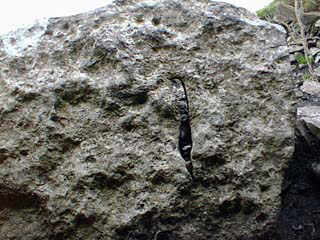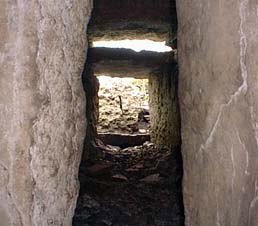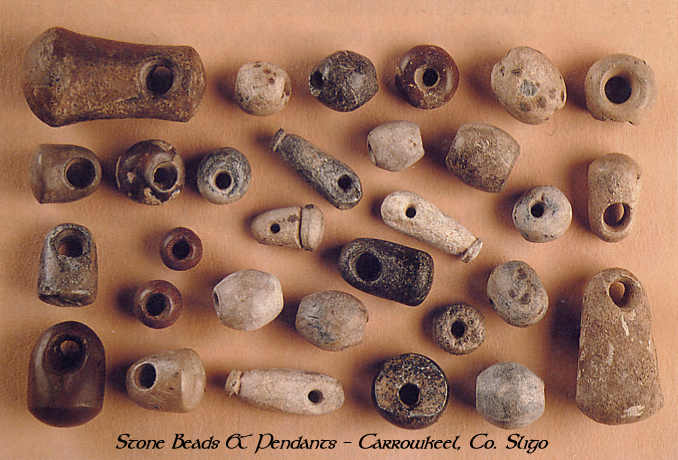|
Location:
Bricklieve Mountains, Co. Sligo,
Ireland. |
Grid Reference:
54� 03.2' N. 08� 22.5' W. |

 Carrowkeel:
(Passage Mound).
Carrowkeel:
(Passage Mound).
There are 14 passage mounds at
Carrowkeel, all in different stages of construction. Although the site suffered an
explosive assault in the 1911 'digs', there are enough remains to show
us that this was once an extremely important part of the Neolithic Irish
landscape.
The
passage mound (Cairn G), was demonstrated by researcher Martin Byrne, to have
a 'light-box' which is similar in design to the light-box at
Newgrange, and was constructed so as
to allow the light of both the the sun and moon to penetrate the inner chamber.
(The sun for a month on either side of the summer solstice, and the light of the
full moon on either side of the winter solstice)
(1).
(Map of Site:
How to get there)
|
Carrowkeel:
('An Cheathr� Chaol',
'The Narrow Quarter'). |
Carrowkeel is a grouping of 14
cairns/passage mounds, with circumstantial dating placing them at around
3,400-3,100 BC. Unfortunately, much of the site was 'vandalised' in 1911
by R. A. S. Macalister who thoroughly attacked them on behalf of the
Royal Irish Academy. He and his assistants employed sledgehammers and
high powered explosives in a two week archaeological frenzy.
Although the site has
14 cairns and a substantial bronze-age 'village' below it, the complex
has been neglected and following the 1911 digs, all that remains today is the
ghost of a memory, with only a few cairns left worth visiting. The
outstanding views however, from Carrowkeel offer a different view of the
landscape in which connections between the prehistoric sites were
reinforced by astronomically significant orientations. In particular, in
the case of Carrowkeel, the distant hill of
Knocknarea
seems to have been of great importance to the builders of these
monuments.
Cairn 'G'.
The most complete of the Carrowkeel complex, is a classic example of a
corbelled, cruciform
passage mound, it was built with a large 'portal' stone in front of the
passage, with just enough of a gap to allow a person access to the
chamber, and with a curious slit like hole in it (most of which is
covered today). It is suggested that light reflecting off the mica
stones at the back of the chamber might have in turn reflected light
back out through the hole, a theory, which if substantiated one day,
would make this the only known example of its kind.
(Interior
Schematic of Cairn G)

The curious hole in
the Carrowkeel 'portal-stone', mostly covered on the front-side.
|
The Light-box - Cairn G.
Martin Byrne is the
re-discoverer of both the solar purpose of Cairn G at Carrowkeel on the
Summer Solstice sunset and the lunar function of the same cairn which
demonstrates that moonlight will enter G and hit the end chamber wall at the
extreme Northerly lunar standstill point.

The location and orientation of the passage
mound was clearly important, and
'capturing the light of the Moon' may have been the main purpose of the
construction - as it is orientated to a hill called
Knocknarea, which means
"Hill of the Moon", which is in-line with
the most northerly point the setting Moon reaches on the horizon, ('lunar
standstill'), an event that only happens every 18.6 years (suggesting a long
construction or preparation time).

The light-box from inside the chamber.
The passage is much shorter than Newgrange, only about two meters long, and
so the roof box opens directly into the chamber. This means that the sun can
shine into the chamber for a much longer period of time than Newgrange -
approximately a month on either side of midsummer, though it only spends
about two weeks in the rear of the chamber. Also, even though the sun has
been displaced by 1.5 degrees (three solar diameters) to the west, it is
impossible for the midsummer sunset to have shone into the end recess of
Cairn G. In the photograph below, the sunbeam is shown in its maximum
position, centred over the left recess, and this is probably pretty much as
it was in ancient times. The full moons rise and set approximately 180
degrees opposite the sun's rising and setting positions. The setting full
moons on either side of the winter solstice will illuminate the chamber of
Cairn G in much the same fashion as the sun does each summer.
(More about light-boxes)
|
Cairn E - Is a composite of a court cairn and passage cairn. The
northern end of Cairn E houses a ruined passage with a cruciform chamber
which, like Cairns B, G and K, is aligned to Queen Maeve's Cairn on
top of
Knocknarea, on the horizon.
Astronomy - While the passage and chamber are oriented to Knocknarea at
337�, the long body of the cairn is aligned on a different axis - 329.5�,
quite close the axis of the midwinter lunar standstill setting azimuth. The
mound laid out on the summer solstice sunset/winter solstice sunrise axis.
Once every 18.6 years at the winter solstice, the full moon will set behind
Croghaun, and moonlight may illuminate the left side of the cross-shaped
chamber. Then, looking south-west along the axis of the cairn, the winter
solstice sun will rise over the court shaped structure.
Cairn K
- This
monument, along with Cairns B and G is the most intact structure at
Carrowkeel and is an excellent early example of the classic cruciform
corbelled chamber with a capstone 3m above the floor.
Up until a
few years ago there was a lot of white quartz around the north face and
entrance of the cairn. but most has been removed by visitors, probably for
souvenirs. This quartz would have been used to cover all of the cairns - see
Newgrange for an example. And this is probably how the mountains got
their name ('Breac Sliabh' means Speckled Mountain), and anyone standing on
Knocknarea
or any of the peaks of the Ox Mountains would have seen the monuments in
Carrowkeel reflecting the light of the sun or moon.
(Ref:
www.carrowkeel.com)

Some of the discoveries from Carrowkeel.
Sill-stones - Several of the cairn's at Carrowkeel have half-buried
sill-stones
in the
ground which appear to divide the chambers from the passages, and
sometimes even
divide the passages into sections. The same design feature can be seen on
sea-faring ships today.
The
Gavr'inis passage mound in
France has a sill stone in the corridor floor with 9 'X's'
carved into its face. Only the top halves are present to today,
but it is an architectural feature with a symbolism mirrored at
several Irish passage mounds both in terms of art and
construction.
(Passage
Mounds)
(Light-Boxes)
(Other
Prehistoric Irish Sites)
|